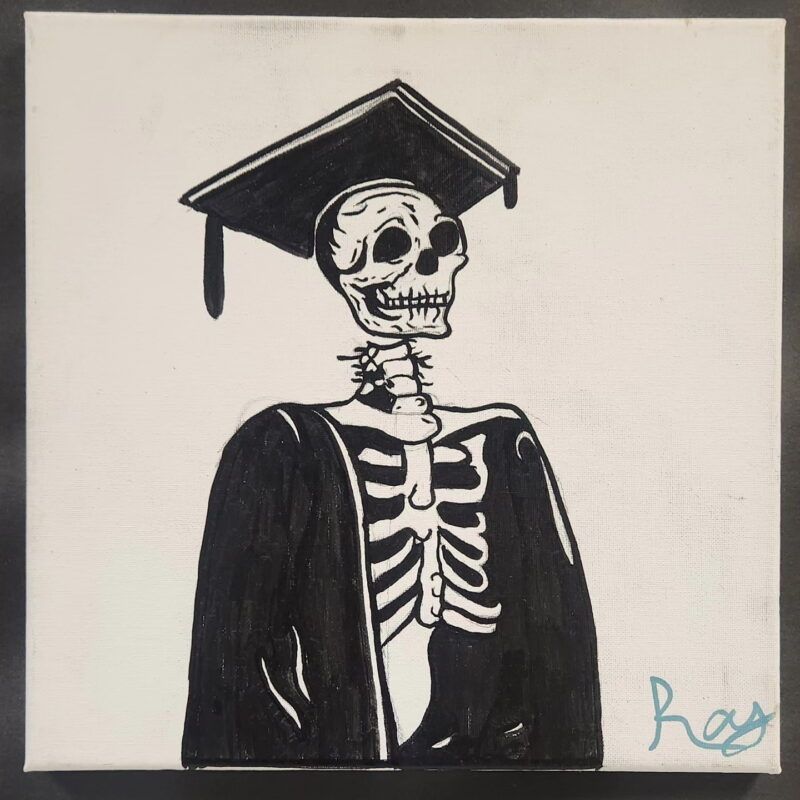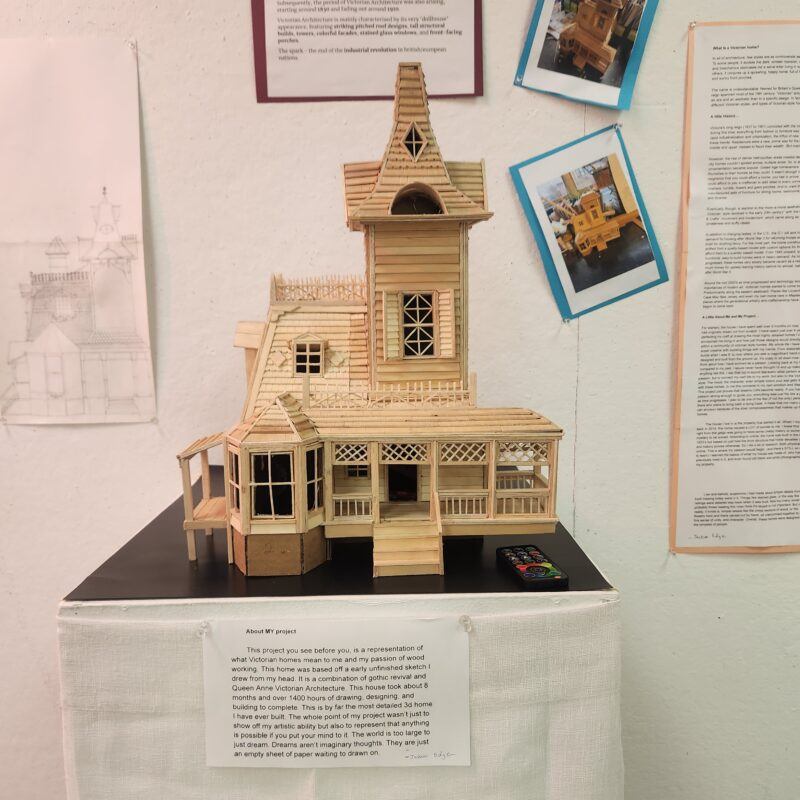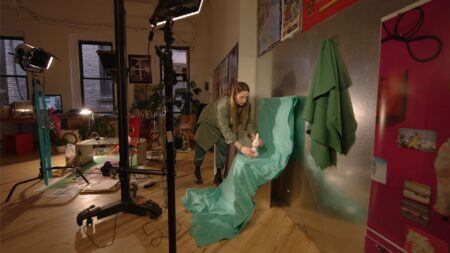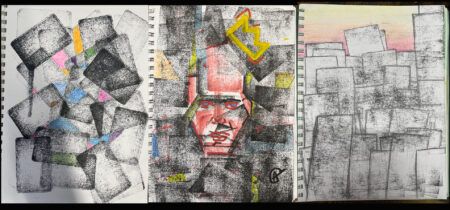
Blue Woman by Lillian Kyle. Courtesy of Kandice Stewart.
Disclaimer: This is an article about failure and wanting to succeed. It’s about those moments when you are giving more than 100% to only receive 50% back: and it’s about the challenging, yet beautiful reality of ideation for young teens.
This past year, I had students investigate their creative strategies and learn pedagogy; yes—pedagogy! When I entered this past school year, I was convinced that students just needed to know “the why” behind art education decision-making and then they would engage with art more. I have been teaching for ten years now, and I have received some highly motivated students throughout my time, but I’ve always had a soft spot for the challenging students. And when I say challenging students, I mean the students who only need my class for the credits, the students who only make art for the A, the students who think art is easy work. That list also includes some of the most respectful and sweet kids, but many who are largely disinterested in or disillusioned with the role of art in society. These students would go on to fuel my curiosity about student engagement and teacher decision-making. Therefore, my goal this past year was to teach them the various entry points to engaging with art education, sort of like how to solve a single math problem with different strategies. And it was a challenge!

Skeleton by Raymond Brown. Courtesy of Kandice Stewart.
I started the year arming students with 3 major art educator approaches: project development, skill development, and experimentation. I provided artist and student examples, held mini workshops with rotating stations, and held whole-class demonstrations to solidify the varying ways to carry out each approach. For example, a typical day looked like: one table of students working on drawing various facial perspectives (skill development), another table working on a collage of “the world’s problems” (project development), and another table experimenting with natural materials like grass, leaves, and dirt to create a 2D artwork. I sat back and was excited! I felt that I was exposing students to the breadth of artistic expression. Little did I realize, though exposure was great, the lack of depth would go on to be a shaky foundation for a long year in Art discovery. Looking back, students were doing many things, but they weren’t engaging with art on a deeper level, consequently undercutting the intention of having a relationship with art-making and having an understanding of the role of art in society.
I proudly saw students learn how to make a syllabus that was carried out each quarter at a time. We co-constructed surveys and formed smaller committees who made decisions about upcoming activities. They designed their own rubrics that superbly upheld artistic integrity. We had student-led announcements and short periods of student-led demonstrations. Yet, with all of these great “things” happening, we were losing time. And I found that students were taking longer and longer to come up with sustainable and thought-provoking ideas for their art. And unfortunately, once whole-group decisions were made, several students felt left out, thus underscoring the alienation of their relationship with art and art-making. Before my maternity leave began, I needed to come up with a way for students to consider their personal connection with art and art-making. I wondered, “How do we see ourselves in art?” and “What does art do for us?”

Victorian house is by Jackson Edge. Courtesy of Kandice Stewart.
One way to close the gap of alienation was the birth of the “Artist a Week” series. Several teachers know that sub plans must include simple, short-term periods of engagement with reflection because it shows evidence of accountability. In my absence, students wouldn’t be able to get away with taking days to think of an idea under someone else’s guide; and most subs are uneasy about providing critiques or encouraging ideation for students. I needed something simple, yet impactful that would continue artistic practice and thinking. We began to use contemporary artists from the Art21 bank. These artists would be my voice while I was gone. They would support students by showcasing real artists’ intentions in their practice. When I returned from maternity leave, I was delighted to hear some students recall artists that resonated: Anicka Yi, Shaun Leonardo, Tanya Aguiñiga, Miranda July, and Azikiwe Mohammed just to name a few.
What I learned was that in order for me, the teacher, to help students see the value in art or have a relationship with their art-making, they needed to see the possibilities of art through someone else’s journey! Shaun Leonardo discusses in “The Freedom to Move” the value of imagining unique possibilities for oneself through art regardless of what you believe to be your place in the world. His story of awakening from being a football player and wrestler turned contemporary artist always gets my students to see their own multifaceted potential.

Zombie by Z Hunt. Courtesy of Kandice Stewart.
Upon my return, I administered a student survey that asked which activities made them most invested in their artistry and journey of becoming an artist. The results were very revealing. They stated that the most challenging part of co-constructing the curriculum this year was ideation and too much freedom. They felt a boost of ideation by following the artists debuted in the “Artist a Week” series. Ultimately, my students didn’t need to learn about which art education strategies worked best: they needed to see real people having real connections with art. I’ve learned that doing many things doesn’t mean that you are doing THE thing that anchors a foundation for artistic connection. And though I had the best of intentions, we were stuck in practicing mechanics that didn’t support personal investigation, which eventually hindered ideation and generative thinking. Essentially, I expected product without proper process.
For next year, I plan to start with who or what defines an artist? I am excited to have vulnerable conversations about how to have a relationship with art. I am looking forward to anchoring in relationships rather than responsibilities. Azikiwe Mohammed is the perfect artist to kick off my year because he self-proclaims as a person who makes stuff. His blurred definition of “artist,” though realistic and even practical, might encourage students who are disinterested and disillusioned to see their own possibilities.
Artists sharing their reasoning for why art matters to them has been an excellent tool for kicking off vulnerable conversations. I hope that this time around my most challenging students might challenge themselves with learning more about their personal connection through art-making.
Watch Kandice’s playlist, “Young Pedagogical Thinkers: A Year of Self-Discovery”
Kandice Stewart is based in the Greater New York City area and lives in New Jersey. She believes that art is love, connection, spirit, energy, life, and healing. Kandice states that she is human first, while also being an educator, mother, caretaker, sister, activist, enthusiast, explorer, student, and collaborator. She has been teaching for over ten years mostly in communities of ethnically diverse backgrounds due to her deep passion for equity and inclusion. She aims to use her work for personal, community and global activism.
Beyond being a proud mother of three amazing human beings, she is a Doctoral student at Columbia University studying teacher identity development in the public sector, and she is a full-time AP Art History and Studio Art teacher at Columbia High School. She has partnered with the Metropolitan Museum of Art, University of Florida’s Art Education program, and the NY Historical Society to offer ways of knowing and sharing the expansive human experience through art. Currently, she helps other Art educators through Teacher’s College, CCNY City College, the Art of Education University, the Academy of Fellows, and Art21 Educator programs to think critically and creatively about their personal arts praxis and pedagogy. She believes that art is the present opportunity to connect with yourself, others and the world.







